My two day trips
My recent travels have been short but interesting: A drive to Rosemont, Illinois (home of O’Hare airport), for the annual World Floral Expo, which caught me up on the global cut flower market; and a slightly longer drive to Elkhart, Indiana, to tour plant testing specialist Agdia, who warned us of the dangers of viruses and viroids.
What’s a viroid? I asked the same question! I’ll tell you in a minute. But first, what’s happening in the world of cut flowers?
Direct deliveries from Kenya
My host at the World Floral Expo, which takes place in various cities around the U.S. each March, was Jasper Van Dijk, organizer of the event. I last attended when it was last in Chicago, four years ago, so I asked Jasper to catch me up on the hot news in cuts. His first comment? Direct flights from Kenya to JFK in New York, which start in October. That should be big for Kenya’s cut flower industry, which currently reaches the U.S. via Europe (Amsterdam, primarily). So I went in search of some Kenyan growers to learn more.
Boaz Chemweno (below) is sales manager for Mzurrie Flowers, a group of four Kenyan rose growers who have about 200 acres of production at various elevations, producing standard and spray roses. Combined, they produce about 100 million stems per year.
He told me that the new flights will cut rose travel time from 2-3 days down to 1 day—which equates to better roses for the end consumer.
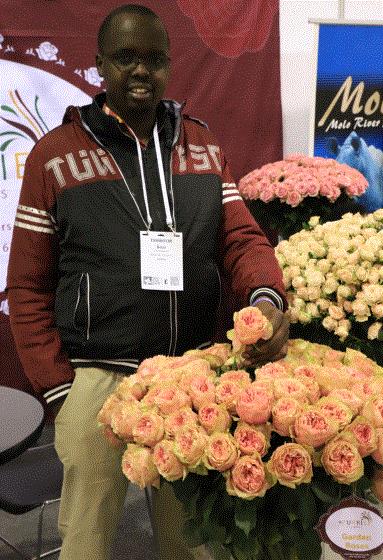
Christopher Kulei of Sian Roses agrees. Sian, founded by Christopher’s father in 1995, has three farms covering almost 250 acres and producing 150 million stems. Christopher told me that cutting out the middleman—in this case, the European exporter—could lower prices for Kenyan roses by up to one-third. The downside? At first there will just be three flights a week to New York, and with limited capacity (the rose cargo will have to share space with luggage on the Kenya Airways 787). Still, it’s a start, and the Kenyans were here to educate American buyers about their quality roses, especially spray roses, which are gaining in popularity (see next for what’s trending in roses).
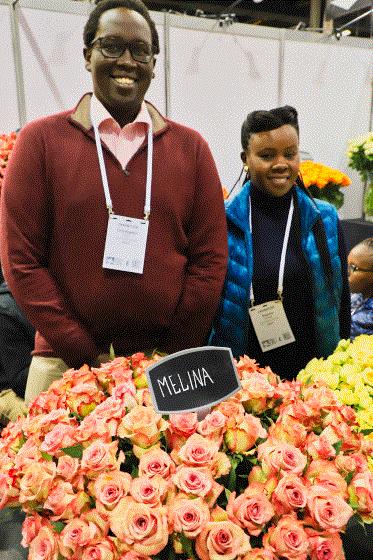
Christopher Kulei and Yvonne Chelagat, a 15-year employee of Sian Roses, with “Melina,” a hybrid tea with a desirable “garden rose” look.

What’s trending in cuts?
Garden roses and spray roses are the hot commodities right now in roses, from what I could gather. Garden roses aren’t actually garden roses, they’re hybrids that have an old-fashioned appearance: full, with many petals in soft vintage shades. And scent, too, in many cases. Boaz is showing off a good example above (sorry, I missed the variety name).
Here's a new garden type, called Romanza, bred by Jan Spek Rozen.
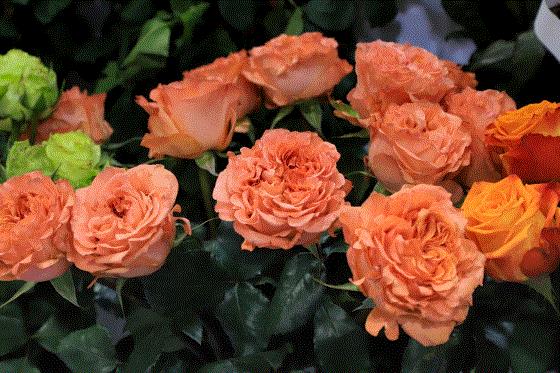
Spray roses continue to gain in popularity, because they fill up bouquets nicely, and are more multi-purpose than standard, large-headed roses. Available in myriad colors, they work for every season in every sort of arrangement, not just weddings.
This is Spray Sahara, from Bellaflor Group of Ecuador. It’s a best-seller for weddings, says Patricia Escobar. Floral designers and brides love the color. They only produce 20,000 stems per month, and they get a 20% price premium for them.
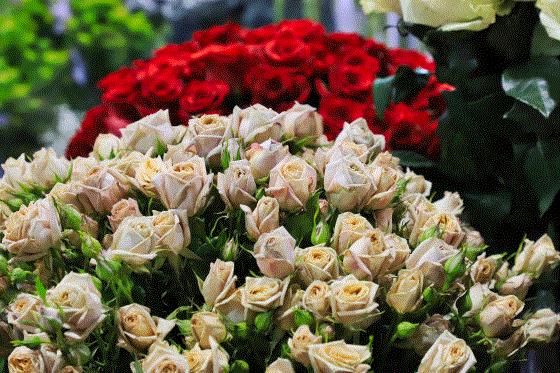
What goes good with roses? Gypsophila. Which I saw dyed in a range of pastel colors. Below is the range offered by Florsani, of Ecuador. Ball Seed's exhibit also showed how colorful gypsophila can be.


Flowers from Alaska
Yes, cut flowers are still grown in America! Maybe not as many roses, mums and carnations as 50 years ago, but there are plenty of cuts on offer.
Peonies from Alaska, for instance. I chatted at length with Wanda Haken, who owns Fox Hollow Peonies, a member of the co-op Arctic Alaska Peonies. Wanda told me that the big deal with Alaska peonies is that they bloom from June to September—after those in the lower 48 and before those imported from the southern hemisphere. That makes them perfect for the all-important summer wedding business.
They’ve only been a “thing” since around 2000, when University of Alaska—Fairbanks hort professor Pat Holloway grew some peonies in the school’s botanical garden. They were slow to establish, but boy did they bloom big once they did—and early, too! She didn’t know that was a big deal, but she mentioned them at a conference, and an Oregon flower grower pointed out their potential summertime niche. She got a grant to set up a demonstration plot in 2001, and the rest, as they say, is history. Today, there are close to a hundred peony farms in Alaska, shipping hundreds of thousands of stems, and Pat is known as the mother of Alaskan peonies.
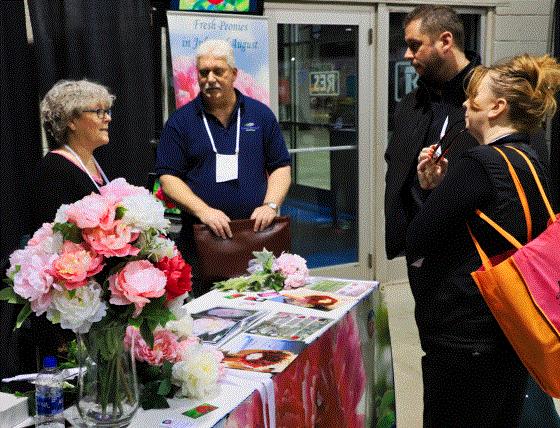 Wanda chats with potential customers from Canada. Alas, the flowers in the vase are silk. “The real ones are under three feet of snow right now,” she joked.
Wanda chats with potential customers from Canada. Alas, the flowers in the vase are silk. “The real ones are under three feet of snow right now,” she joked.
Wanda, a teacher, first gave peonies a try in 2010 after a brush fire inadvertently cleared five acres of her woods. She started with 200 plants and now has 5,000, producing about 20,000 flowers. (The older the plants get, the more they’ll produce. A plant can last upwards of 30 years.)

Cut phalaenopsis from the Garlic Capital
There’s nothing too special about orchids these days, especially phalaenopsis, but potted plant grower South Pacific Orchids of Gilroy, California, has found a niche in cut phals—including colorful dyed flowers. Sales manager Jason Phan told me they started into the niche about six years ago. He wouldn’t say how many stems they sell, but did say that 75% of them are white (good for dyeing, of course), 20% are purple, and the rest are seasonal colors.
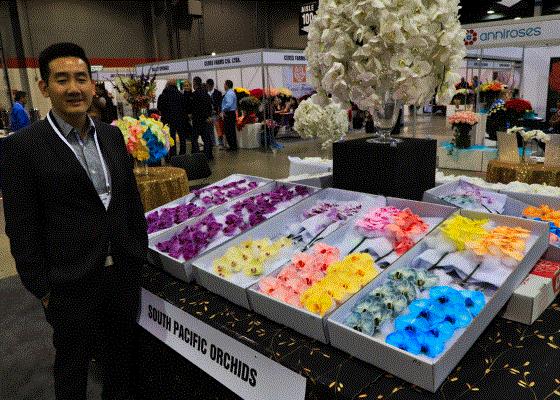
A tour of Agdia
On Tuesday, I, along with Jen Zurko and Allison Westbrook, got a hardcore lesson in plant pathology during a tour of Agdia. Agdia is best known for developing ELISA (enzyme-linked immunosorbent assay) and “ImmunoStrip” test kits for agricultural crops. Agdia was founded in 1981 by Dr. Chet Sutula, a chemist for Miles Laboratories who found a way to bring the new ELISA-testing technology to agriculture. Today, they offer about 60 different tests, including for GMOs (such as for Roundup-Ready corn and soybeans). They specialize in viruses, and test for 18 of them in ornamentals.

Molecular biologist Bryant Davenport helps develop new tests based on the pathogen's DNA. High-level stuff goes on at Agdia!
Today, Chet’s son-in-law Bazial Vrient is owner. He showed us everything they do—molecular and antibody R&D, test kit manufacturing, quality control, Testing Services—and then we lunched while listening to a lecture on viroids and more by Debi. Enlightening! Allison especially enjoyed it, as she’s working on a master’s degree in plant health even as she handles customer service, circulation and some writing and editorial duties for us.

Baziel Vrient
What was most impressive to me is the high level of biosecurity at which Agdia operates. The only other plant lab in the U.S. with as high a biosafety level is the USDA’s own labs. It could operate as a branch of the Centers for Disease Control (CDC) with few modifications. They are ISO 17025 certified, and are constantly audited by, well, everybody. It’s unlikely a disease will ever slip out of their doors.
What was the main takeaway, after spending several hours talking about diseases? Testing prevents disease outbreaks. They’ve done millions of tests over the years, and they’ve seen that when companies test diligently, then reduce their testing frequency, the incidence of positive tests increase. Perhaps they get a false sense of security—“We’ve done all this testing and never found a virus, so why test so much?”—and they lower their guard.
What in the world is a “viroid”?
When I first heard the term, used by Agdia Testing Services Director Debi Groth-Helms, I assumed it was plural for “virus.” Nope, a viroid is its own thing, and apparently they’re everywhere.
Debi defined a viroid as a “mechanically transmitted, infectious RNA,” and she called them “an emerging problem for ornamentals.” Viroids are the smallest infectious pathogens known (80 times smaller than viruses). They are a single strand of RNA with no protein coat. They were discovered in 1971, when they were identified as the cause of potato spindle tuber disease. Viroids cause all sorts of plant maladies, from benign leaf distortions to devastation, such as the aforementioned potato disease, and coconut cadang-cadang viroid, which kills coconut palms. There are also viroid diseases that affect cucumbers, tomatoes, apples, citrus, hops, avocados and grapes, among other important crops. So far, 32 viroid diseases have been identified, of which nine (the pospiviroids) are common in greenhouse crops.
What do viroids mean to you? Well, first of all, the only known human disease caused by a viroid is hepatitis D, so that’s one thing you don’t have to lose sleep over.
Second, there are only a few ornamental diseases that are currently attributed to viroids. The best known are chrysanthemum chlorotic mottle (CChMVd) and chrysanthemum stunt viroid (CSVd). There are also viroids found in dahlia, iresine and portulaca. I’m sure that list will grow as more research is done. They don’t necessarily cause a problem if there’s no other disease present—in fact, a 2017 survey by Agdia of random plants from local garden centers found that 15% of them contained viroids! They were asymptomatic, but the viroids were present.
Third, like viruses, there are no preventative or curative products for viroids—sanitation is the only prevention, and disposal is the only cure. Viroids are easily transmitted by pruning tools, clothes, human hands, or an infected plant simply touching another plant.
The biggest issue with viroids on ornamentals is that they can potentially spread disease to food crops, such as potatoes. If an ornamental crop is implicated in something like that, it could be bad news for us! Which is why it's important we get educated on the topic.
Now that viroids are on our radar, we will be doing some in-depth editorial on the topic in GrowerTalks in coming months. Until then, just keep utilizing your good IPM practices and you can sleep at night.
In the meantime, if you want to know more about viroids, Debi suggested a couple of summary articles:
http://www.apsnet.org/publications/apsnetfeatures/Pages/Viroids.aspx
https://www.sciencedirect.com/science/article/pii/B9780128014981000036

Finally …

Finally, a non-Christmas use for poinsettias: diplomacy! These poinsettias (and ferns) graced the recent meeting between North Korea and China.
Let’s hope they inspired the holiday spirit of peace and goodwill.
See you next time!

Chris Beytes
Editor
GrowerTalks and Green Profit
This e-mail received by 22,980 loyal readers!
Thanks to my loyal sponsors, who help me reach the 22,980 readers of Acres Online in 66 countries. (Sorry, North Korea is not one of them. But China is!) Want to be a sponsor? Give Paul Black a shout and he'll hook you up.